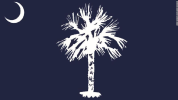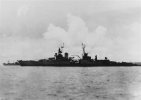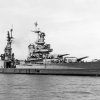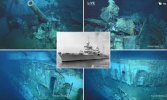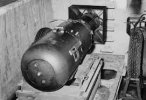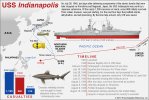-
Please take a moment and update your account profile. If you have an updated account profile with basic information on why you are on Air Warriors it will help other people respond to your posts. How do you update your profile you ask?
Go here:
Edit Account Details and Profile
You are using an out of date browser. It may not display this or other websites correctly.
You should upgrade or use an alternative browser.
You should upgrade or use an alternative browser.
Ship Photo of the Day
- Thread starter Randy Daytona
- Start date
Yes...Didn't a 3 Essex class commission as Wasp, Yorktown and Hornet also?
CV-9 ESSEX
CV-10 YORKTOWN
CV-12 HORNET
CV-18 WASP
A lot of the ESSEX class carriers started out as one name and were renamed after a war loss, for instance LEX was originally named CABOT.
Happened upon this article:
https://www.thedrive.com/the-war-zo...udZoBb6cD7uzY5wbP5nmiQL1gODRqrIKkLNqQzLYFR2BI
Named after Paul Hamilton (3rd Secretary of the Navy and 42nd Governor of South Carolina), the USS Paul Hamilton DDG-60 is an Arleigh Burke class destroyer.
The Moultrie Flag came from the successful defense of Sullivan’s Island and Charleston by Colonel Moultrie and the 2nd South Carolina regiment against the British in June 1776. The flag became the basis of the South Carolina state flag which, despite being one of the oldest and iconic state flags, has never been standardized with different crescents, Palmetto trees and blues at different times. The legislature is now creating the definite flag, although the first attempt of the flag drawn by historians was hilariously bad.
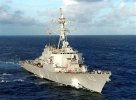
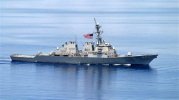
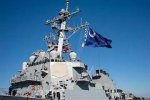
https://www.thedrive.com/the-war-zo...udZoBb6cD7uzY5wbP5nmiQL1gODRqrIKkLNqQzLYFR2BI
Named after Paul Hamilton (3rd Secretary of the Navy and 42nd Governor of South Carolina), the USS Paul Hamilton DDG-60 is an Arleigh Burke class destroyer.
The Moultrie Flag came from the successful defense of Sullivan’s Island and Charleston by Colonel Moultrie and the 2nd South Carolina regiment against the British in June 1776. The flag became the basis of the South Carolina state flag which, despite being one of the oldest and iconic state flags, has never been standardized with different crescents, Palmetto trees and blues at different times. The legislature is now creating the definite flag, although the first attempt of the flag drawn by historians was hilariously bad.



I don't think there have been any Australian ships posted as of yet, so here is HMAS Australia, the only capital ship of the Australian Navy. One of three Indefatigable class battlecruisers, she was kept in the Pacific at the beginning of WW1 as the Australia was more powerful than any ship in the Imperial German Navy's East Asia Squadron. After the Battle of the Falkland Islands destroyed most of the East Asia Squadron, HMAS Australia was transferred to the Atlantic. Unfortunately, she collided with her sister ship HMS New Zealand and missed the Battle of Jutland. After the war, the ship fell victim to the Washington Naval Treaty and was scuttled in 1924. One of the propellers remains on display at the Australian War Museum.
Length: 590 ft, Beam: 80 ft, Displacement: 22,100 tons
31 coal burning Babcock & Wilcox boilers fed 2 sets of steam turbines going to 4 shafts. Design was for 44,000 HP and 25 knots, but ended up producing 55,000 HP and 26.9 knots.
Main armament: 8 (4x2) 12"/45 caliber rifles throwing 850 lb shells to 25,000 yds.
Secondaries: 16 (16x1) 4" guns, 2 18" torpedo tubes
Armor: Belt: 4"-6", Deck: 1.5" - 2.5", Turrets: 7"
Commissioned: 21 June 1913, Decommissioned: 12 December 1921 Scuttled: 12 April 1924

 en.wikipedia.org
en.wikipedia.org
As a side note, here is the wikipedia page explaining the Royal Navy's Pennant system for numbering.
 en.wikipedia.org
en.wikipedia.org
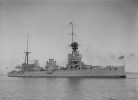
Side view of a large warship with three funnels and two large masts at rest on flat water.
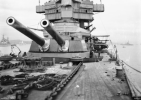
Australia's forward turret ('A') in 1918; note the port (i.e. left-side) wing turret in the background with a biplane on its roof
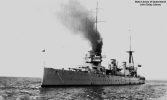
Australia at anchor in Queensland waters
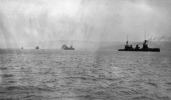
Australia leading the ships of the Australian Naval and Military Expeditionary Force into Rabaul Harbour on 12 September 1914
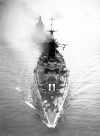
Australia leading a line of ships under the Forth Bridge
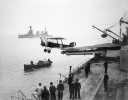
A Sopwith 1½ Strutter launching from one of Australia's turrets
Length: 590 ft, Beam: 80 ft, Displacement: 22,100 tons
31 coal burning Babcock & Wilcox boilers fed 2 sets of steam turbines going to 4 shafts. Design was for 44,000 HP and 25 knots, but ended up producing 55,000 HP and 26.9 knots.
Main armament: 8 (4x2) 12"/45 caliber rifles throwing 850 lb shells to 25,000 yds.
Secondaries: 16 (16x1) 4" guns, 2 18" torpedo tubes
Armor: Belt: 4"-6", Deck: 1.5" - 2.5", Turrets: 7"
Commissioned: 21 June 1913, Decommissioned: 12 December 1921 Scuttled: 12 April 1924

HMAS Australia (1911) - Wikipedia
As a side note, here is the wikipedia page explaining the Royal Navy's Pennant system for numbering.
Pennant number - Wikipedia

Side view of a large warship with three funnels and two large masts at rest on flat water.

Australia's forward turret ('A') in 1918; note the port (i.e. left-side) wing turret in the background with a biplane on its roof

Australia at anchor in Queensland waters

Australia leading the ships of the Australian Naval and Military Expeditionary Force into Rabaul Harbour on 12 September 1914

Australia leading a line of ships under the Forth Bridge

A Sopwith 1½ Strutter launching from one of Australia's turrets
Last edited:
The Moultrie Flag came from the successful defense of Sullivan’s Island and Charleston by Colonel Moultrie and the 2nd South Carolina regiment against the British in June 1776. The flag became the basis of the South Carolina state flag which, despite being one of the oldest and iconic state flags, has never been standardized with different crescents, Palmetto trees and blues at different times. The legislature is now creating the definite flag, although the first attempt of the flag drawn by historians was hilariously bad.
View attachment 32636
There is a relatively robust debate about whether the crescent is a crescent moon or a gorget, which by the time the flag was created was a ornamental uniform item. Why would I know about this? My school's flag is a version of the South Carolina flag, with the crescent facing the opposite direction, and some folks with more time than I have been studying and debating the origin of the crescent and its meaning.
George Washington wears a gorget in this portrait of him as an officer in the French and Indian War.
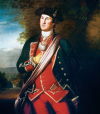
Gorgets were essentially a rank device. American snipers would target Brits with gorgets.There is a relatively robust debate about whether the crescent is a crescent moon or a gorget, which by the time the flag was created was a ornamental uniform item. Why would I know about this? My school's flag is a version of the South Carolina flag, with the crescent facing the opposite direction, and some folks with more time than I have been studying and debating the origin of the crescent and its meaning.
George Washington wears a gorget in this portrait of him as an officer in the French and Indian War.
View attachment 32656
There is a relatively robust debate about whether the crescent is a crescent moon or a gorget, which by the time the flag was created was a ornamental uniform item. Why would I know about this? My school's flag is a version of the South Carolina flag, with the crescent facing the opposite direction, and some folks with more time than I have been studying and debating the origin of the crescent and its meaning.
George Washington wears a gorget in this portrait of him as an officer in the French and Indian War.
View attachment 32656
My readings of the history of the SC flag lead me to believe it is a uniform item. That it is a crescent shape and resembles a crescent moon has led to a lot of confusion.
Did you see the proposed redesign of the Palmetto tree? Some have compared it to Charlie Brown’s Christmas tree - thankfully, that particular redesign will not be adopted.
My readings of the history of the SC flag lead me to believe it is a uniform item. That it is a crescent shape and resembles a crescent moon has led to a lot of confusion.
I see good arguments on both sides, am relatively agnostic to it though.
Did you see the proposed redesign of the Palmetto tree? Some have compared it to Charlie Brown’s Christmas tree - thankfully, that particular redesign will not be adopted.
Yes, it was atrocious.
Like the "An Appeal To Heaven" tree?My readings of the history of the SC flag lead me to believe it is a uniform item. That it is a crescent shape and resembles a crescent moon has led to a lot of confusion.
Did you see the proposed redesign of the Palmetto tree? Some have compared it to Charlie Brown’s Christmas tree - thankfully, that particular redesign will not be adopted.
The current flagship of the Australian Navy is HMAS Canberra, a LHD. Along with its sister ship HMAS Adelaide, they were both based on the Spanish Juan Carlos I class LHD. Designed to carry 1,000+ troops (1,600 in overload) and 110 vehicles on 2 vehicle decks, it also has a well deck 227' x 55' well deck that carries 4 landing craft. All of the amphibious capability comes at a price of only having 10,700 sq ft of hangar space (for comparison the USS America has 28,000 sq ft and Japan's Izumo class has 44,000 sq ft). While many navies are looking at utilizing F-35B's from their LHD's, a study said the conversion of the Canberra class to primarily operate the JSF would be too expensive.
Length: 757 ft, Beam: 105 ft, Displacement: 27,500 tons
Powerplant: 1 GE LM2500 Gas turbine of 25,000 HP and 2 Navantia diesels of 9,900 HP each for 20+ knots
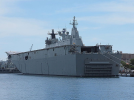
Stern view of Canberra
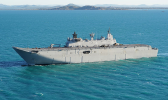
Canberra in 2021
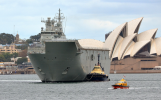
Length: 757 ft, Beam: 105 ft, Displacement: 27,500 tons
Powerplant: 1 GE LM2500 Gas turbine of 25,000 HP and 2 Navantia diesels of 9,900 HP each for 20+ knots

Stern view of Canberra

Canberra in 2021

With the national elections in Germany today to replace Chancellor Merkel after 16 years, I thought about taking a looking at the German Navy. Their equivalent to the US Montana class was the never built H class. While the proposals went from H-39 to H-44, the biggest one their shipyards could have conceivably built was the H-41.
Length: 925 ft, Beam: 128 ft, Displacement: 76,000 tons
Powerplant: 12 MAN diesels combined with steam feeding 3 shafts giving 28.8 knots and an astonishing 20,000NM range at 19 knots.
Main armament: 8 (4x2) 16.5" cannons,
Secondaries: 12 (6x2) 5.9", 16 (8x2) 4.1", many AA guns.

 en.wikipedia.org
en.wikipedia.org
Length: 925 ft, Beam: 128 ft, Displacement: 76,000 tons
Powerplant: 12 MAN diesels combined with steam feeding 3 shafts giving 28.8 knots and an astonishing 20,000NM range at 19 knots.
Main armament: 8 (4x2) 16.5" cannons,
Secondaries: 12 (6x2) 5.9", 16 (8x2) 4.1", many AA guns.

H-class battleship proposals - Wikipedia
The Kriegsmarine’s first capital ship was Scharnhorst, the lead of 2 ships. It led an active life including the sinking of the aircraft carrier HMS Glorious which included one of the longest ranged shots of the war at 28,000 yards.
Sent to intercept convoys headed to Russia, she engaged a British force headed by the battleship HMS Duke of York at the Battle of the North Cape. Having the bad luck to have her radar destroyed by gunfire, she was increasing her distance away from the British battleship when she was hit by a 14” shell in the boilers which slowed her to attack by destroyers, resulting in hits by 4 torpedoes. Thus further slowed, she was sent to the bottom by torpedoes and gunfire. Of note, the Scharnhorst was designed to take 6 (3x2) of the big 15” SK C 34 rifles firing 1,800 lb shells (same guns as the Bismarck) however due to expediency she was much more lightly armed with 9 C 34 rifles firing 740 lb shells - big difference.
Length: 770’ 8”. Beam: 98’ 5”, Displacement: 38,700 tons
Powerplant: 3 steam turbines produced 159,500 hp for 31 knots
Main armament: 9 (3x3) 11”/54.5 caliber C34 rifles firing 740 lb shells
Secondaries: 12 (4x2),(4x1) 5.9”, 14 4.1”AA, many 37mm and 20mm AA
Armor: Belt: 13.8”, Deck: 4.1”, Turrets: 14.1”
Commissioned: 7 Jan 1939, Sunk: 26 Dec 1943
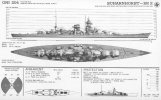
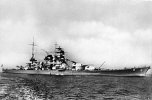
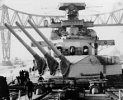
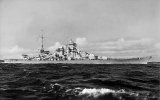
Sent to intercept convoys headed to Russia, she engaged a British force headed by the battleship HMS Duke of York at the Battle of the North Cape. Having the bad luck to have her radar destroyed by gunfire, she was increasing her distance away from the British battleship when she was hit by a 14” shell in the boilers which slowed her to attack by destroyers, resulting in hits by 4 torpedoes. Thus further slowed, she was sent to the bottom by torpedoes and gunfire. Of note, the Scharnhorst was designed to take 6 (3x2) of the big 15” SK C 34 rifles firing 1,800 lb shells (same guns as the Bismarck) however due to expediency she was much more lightly armed with 9 C 34 rifles firing 740 lb shells - big difference.
Length: 770’ 8”. Beam: 98’ 5”, Displacement: 38,700 tons
Powerplant: 3 steam turbines produced 159,500 hp for 31 knots
Main armament: 9 (3x3) 11”/54.5 caliber C34 rifles firing 740 lb shells
Secondaries: 12 (4x2),(4x1) 5.9”, 14 4.1”AA, many 37mm and 20mm AA
Armor: Belt: 13.8”, Deck: 4.1”, Turrets: 14.1”
Commissioned: 7 Jan 1939, Sunk: 26 Dec 1943




Nice looking infographic...but Indy only delivered components for Little Boy...or as Quint calls it, "the Hiroshima bomb."A few more photos of USS Indianapolis - and one of the greatest speeches in movie history given by Robert Shaw.
View attachment 32806
View attachment 32811
View attachment 32810
View attachment 32809
View attachment 32807

